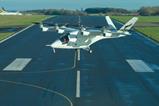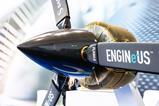Airbus Helicopters has indicated that an issue affecting the cockpit displays of the H160 remains a stumbling block to the new medium-twin gaining certification in the USA.
But programme manager Gilles Armstrong, briefing journalists on 14 February, said that he remains confident of gaining US Federal Aviation Administration (FAA) validation in 2023 – almost three years after the rotorcraft’s initial European type approval was secured.

Some certification delays can be attributed to the Covid-19 pandemic and its impact on the FAA, but a problem with simultaneous blanking of multiple multi-function displays (MFDs) in the cockpit of the H160 – first discovered on other helicopters in the manufacturer’s range – also “remains one of the topics we have to solve in the context of the FAA certification”, says Armstrong.
Currently the subject of an airworthiness directive from the European Union Aviation Safety Agency, the issue requires operators of the H160, and other types, to conduct regular inspections of the MFDs or face certain operational restrictions.
The corrective actions are “very simple” in relation to continued airworthiness but “in initial certification it’s something where we need to keep working on the path to certification with the FAA and that means effectively managing the corrective solution to that in the short term”, says Armstrong.
An H160 ultimately destined to be used for route-proving trials by oil and gas operator PHI is currently in the USA and is assisting with certification work, including a recent maintenance evaluation; its presence has been “very useful in discussions with the FAA”, he adds.
Delays to the that delivery – and the tests by PHI – have been greeted with “understanding” by the operator and its customer Shell, Armstrong adds.
Delivery of the H160 into the offshore segment later this year will be followed by the first example for law enforcement missions – one of 10 units ordered by the French Gendarmerie Nationale (GN).
Final assembly of the lead helicopter from that contract began in 2022, with power-on achieved in January this year. In total, three of the GN’s new rotorcraft are in production with the intention of achieving service entry in time for the 2024 Olympic Games in Paris.
To date, Airbus Helicopters has revealed deliveries of the H160 to three customers: All Nippon Helicopters in Japan, Babcock for operation by the French navy, and a private operator in Brazil. However, Armstrong says the type is now in service with “five to six different operators”.
Cirium fleets data lists French firm Mont Blanc Helicopteres as also operating a single example, with a VIP-configured ACH160 – registered to the flight department of construction machinery manufacturer JCB – also recently sighted at the airframer’s UK base at Oxford airport. Another unit, OY-HRD, is listed on the Danish civil aircraft register.

Airbus Helicopters is now focused on ramping up production of the type to address its backlog of over 100 units. An initial increase in output will be achieved over the next 24 months, says Armstrong, on the back of a “very significant improvement” in industrial performance in 2022.
That saw the number of days required to produce each helicopter cut by a factor of three, he says, adding: “The plan is very aggressive – we have to deliver those sorts of improvements,” he says.
“It shows the time wasted on teething problems is being eliminated very fast; it shows we are going down the learning curve.”
Armstrong declines to reveal precise output targets for the coming years, however. In addition, he notes that a second ramp-up will be required later this decade as the airframer builds the H160M Guepard for the French armed forces.
In all, France plans to take 169 units for its army, navy and air force; 30 helicopters are already on contract. An initial civil prototype fitted with military mission equipment will begin flying later this year, he adds.































